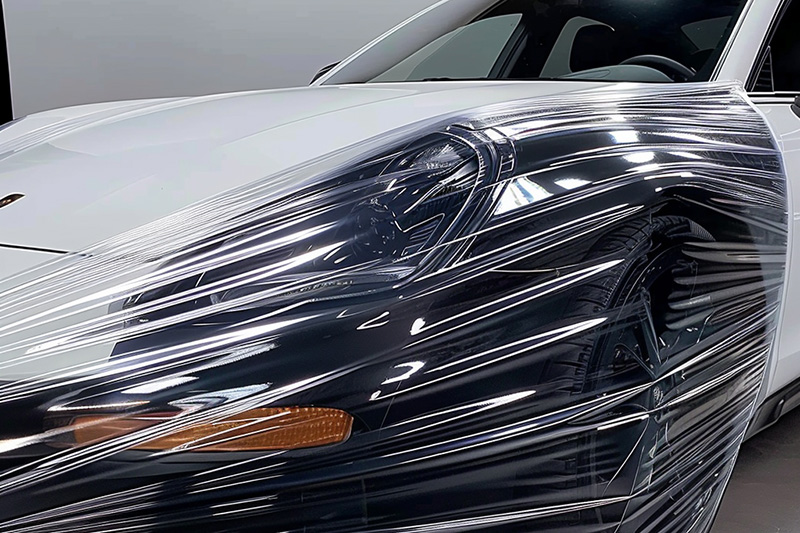Paint Protection Film and Sustainability: Reducing Waste and Environmental Impact
In the eco-conscious world of car care, car owners are constantly seeking solutions that balance protecting their vehicles with minimizing environmental impact. Paint Protection Film (PPF), a transparent film applied to a car's exterior, offers a powerful shield against scratches, chips, and the elements. But is PPF itself an environmentally friendly choice? Let's explore both sides of the story to understand how PPF can be a surprisingly sustainable option.

The Environmental Case for Paint Protection Film
Traditional car care practices often have hidden environmental costs. Frequent repaints involve paints containing volatile organic compounds (VOCs) released during the process, contributing to air pollution. Here's how PPF offers a more sustainable alternative:
- Reduced Paint Waste: By acting as a protective barrier, Paint Protection Film minimizes the need for repaints. This translates to a significant reduction in VOC emissions associated with the painting process. Fewer repaints due to PPF's protective qualities mean a cleaner environment.
- Enhanced Durability: High-quality Paint Protection Film boasts a lifespan of several years. This durable film shields the paint from scratches, fading, and other wear-and-tear, extending the longevity of the original paint job. By reducing the need for premature replacements and repaints, PPF contributes to a more sustainable car ownership experience.
- Less Frequent Car Washes: Some Paint Protection Films possess hydrophobic properties, repelling water and dirt. This characteristic can potentially lead to less frequent car washes. Fewer car washes translate to a reduction in water consumption and the environmental impact of car wash chemicals.
Environmental Considerations of Paint Protection Film
While PPF offers undeniable benefits for car owners seeking to protect their paint and reduce repainting, it's important to acknowledge the environmental considerations associated with its production and disposal:
- Material Waste: The manufacturing process for Paint Protection Film itself can generate waste materials. While advancements are being made in using recycled materials in PPF production, there's still room for improvement.
- Disposal Challenges: Improper disposal of used Paint Protection Film can contribute to landfill waste. Unfortunately, finding recycling options specifically for PPF can be limited depending on your location. Responsible disposal of used PPF is crucial to minimizing its environmental impact.
- Energy Consumption: The production and transportation of Paint Protection Film require energy consumption, contributing to the overall environmental footprint of the product. Finding ways to optimize production processes and utilize renewable energy sources can help minimize the environmental impact of PPF.
Sustainable Practices for PPF Users
Eco-conscious car owners who choose Paint Protection Film can leverage its benefits while minimizing its environmental impact by following these sustainable practices:
- Choose Reputable Brands: Look for companies that prioritize eco-friendly practices in Paint Protection Film manufacturing. These companies might utilize recycled materials in their PPF production or invest in renewable energy sources to power their facilities. By supporting such brands, you contribute to a more sustainable PPF industry.
- Professional Installation: Proper installation minimizes material waste due to errors or improper application. A professional installer with experience in applying Paint Protection Film ensures a flawless application, eliminating the need to redo the process due to mistakes, which would result in wasted material.
- Responsible Disposal: Research recycling options for used Paint Protection Film in your area. If recycling isn't available, ensure proper disposal at a waste facility that accepts tego polymers, the main component of PPF. Disposing of used PPF responsibly prevents it from ending up in landfills and contributing to environmental pollution.
- Targeted Application: Consider using Paint Protection Film strategically on high-impact zones, such as bumpers, doors, and fenders, instead of opting for full coverage. This targeted approach reduces the amount of material used, minimizing the environmental impact associated with PPF production.
The Bottom Line
While PPF production and disposal have some environmental drawbacks, its benefits in reducing paint waste, car washes, and the need for repaints can offer a counterbalance. By making informed choices and adopting sustainable practices, eco-conscious car owners can leverage the advantages of Paint Protection Film while minimizing its environmental impact.
The Future of Sustainable PPF
The good news is that the world of Paint Protection Film is constantly evolving towards more eco-friendly options. Some companies are exploring bio-based materials for PPF production, offering a more sustainable alternative to traditional materials. Additionally, research is ongoing to improve recycling capabilities for used film, further reducing the environmental footprint of PPF throughout its lifecycle.
Overall, Paint Protection Film can be a viable choice for environmentally conscious car owners who prioritize paint protection while taking steps to minimize the environmental impact. By following the tips mentioned above and opting for sustainable practices, car owners can enjoy the long-lasting benefits of PPF with a clear conscience.
